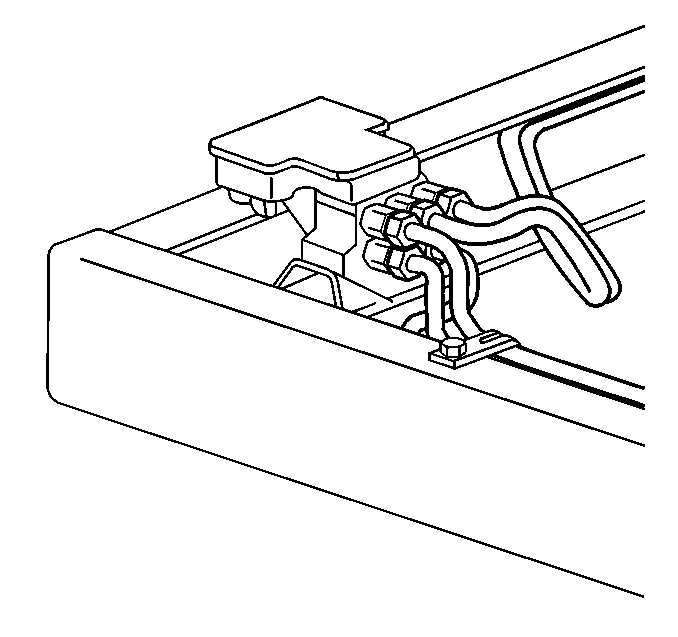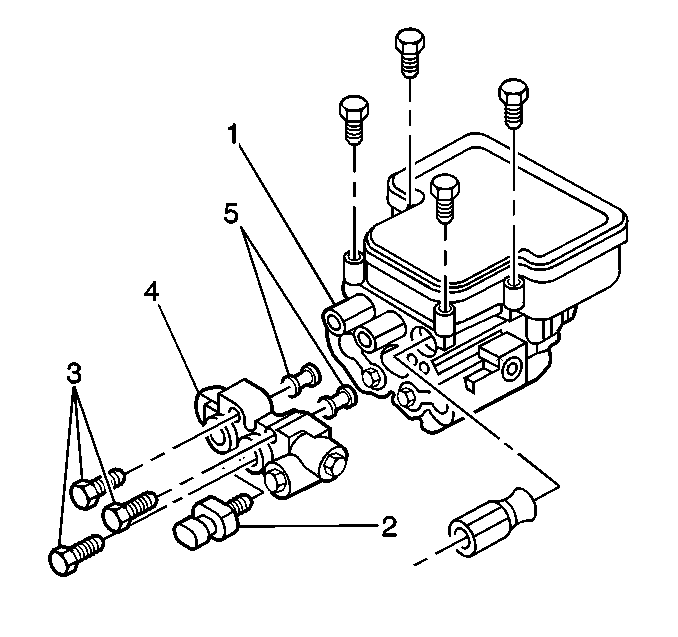Removal Procedure
- Disconnect the negative battery cable.
- Raise the vehicle.
- Support the vehicle with safety stands.
- Remove the electrical connector from the brake pressure differential switch.
- Remove the front and the rear brake pipes.
- Remove the bolts (3) securing the combination valve (4) to the brake pressure modulator valve (BPMV) (1).
- Remove the combination valve from the BPMV.
- Remove the transfer tubes (5).

Caution: Unless directed otherwise, the ignition and start switch must be in the OFF or LOCK position, and all electrical loads must be OFF before servicing any electrical component. Disconnect the negative battery cable to prevent an electrical spark should a tool or equipment come in contact with an exposed electrical terminal. Failure to follow these precautions may result in personal injury and/or damage to the vehicle or its components.

Important: Note the identification code on the combination valve. The new valve must have the same identification number as the old valve.
Installation Procedure
Important: Verify that the replacement combination valve has the same identification code as the code on the old combination valve.
- Install the new transfer tubes (5) into the combination valve (4) until fully seated.
- Install the combination valve to the BPMV (1).
- Install the combination valve bolts (3).
- Install the brake pipes to the combination valve.
- Connect the combination valve electrical connector to the brake pressure differential switch (2).
- Remove the safety stands.
- Lower the vehicle.
- Connect the negative battery cable.
- Bleed the brake system. Refer to Hydraulic Brake System Bleeding .

Important: Do not reuse the transfer tubes. Always install new transfer tubes with the new combination valve.
Notice: Use the correct fastener in the correct location. Replacement fasteners must be the correct part number for that application. Fasteners requiring replacement or fasteners requiring the use of thread locking compound or sealant are identified in the service procedure. Do not use paints, lubricants, or corrosion inhibitors on fasteners or fastener joint surfaces unless specified. These coatings affect fastener torque and joint clamping force and may damage the fastener. Use the correct tightening sequence and specifications when installing fasteners in order to avoid damage to parts and systems.
Tighten
Tighten the bolts first to 8 N·m (6 lb ft.),
then to 16 N·m (12 lb ft).

Tighten
Tighten the brake pipe fittings to 24 N·m (18 lb ft).

Caution: Unless directed otherwise, the ignition and start switch must be in the OFF or LOCK position, and all electrical loads must be OFF before servicing any electrical component. Disconnect the negative battery cable to prevent an electrical spark should a tool or equipment come in contact with an exposed electrical terminal. Failure to follow these precautions may result in personal injury and/or damage to the vehicle or its components.
Important: Verify that the combination valve metering rod is pressed during bleeding.
